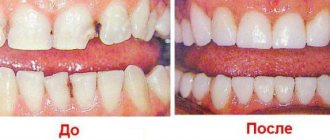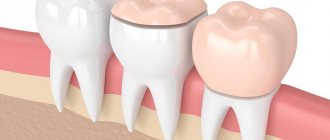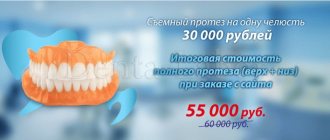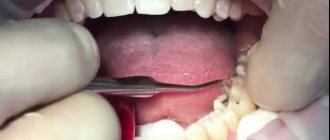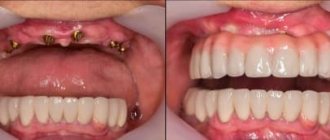As you know, most species of sharks completely change their teeth several times during their lives, and some of these dangerous predators manage to do this every few weeks. A person lives with one “set” all his life. At the same time, poor ecology, poor oral hygiene, unhealthy food, caries and other dental diseases do their job - they destroy our teeth. Fortunately, modern dentistry has a whole arsenal of tools for their restoration. Which ones exactly - says the chief physician, therapist and esthetician of the AktivStom clinic in Moscow, Yana Valentinovna Fedorova.
Teeth extension methods
Modern dentistry offers various methods and technologies for teeth extension. The choice of method depends on the patient’s financial capabilities and indications. Repairing a badly broken tooth will require such a drastic decision as installing a crown. A small chip can be corrected using composite materials. If a tooth has lost around 10–20% of tissue, then this is an indication for the installation of indirect ceramic veneers (provided that the patient does not suffer from tooth wear).
Does it hurt to grow teeth?
Tooth extension is a painless procedure. Anesthesia is not performed if the damage is not significant, since manipulations are carried out at a superficial level. If the damage is severe, the dentist administers local anesthesia. Modern drugs begin to act immediately after administration.
After the session, the first day you may experience pain if the canals were cleaned. Painkillers will help you feel better.
The restored dentition will last a long time if the patient provides proper care. If the question arises about whether it is possible to smoke after tooth extensions, the answer will be negative. Composite and photopolymer materials quickly absorb all substances, which is why the filling quickly changes color. Maintaining hygiene and regular visits to the dentist will help you maintain your smile for a long time.
Teeth extension using composite materials
Modern filling materials used for the restoration of front teeth harden only under the influence of the rays of a special lamp, most often an ultraviolet one. This gives the specialist the opportunity to carefully restore the natural shape of the damaged tooth. This is especially important when reconstructing large chips. However, after curing, the composite material becomes no less durable than a natural tooth, and if the doctor follows all standards and protocols, the junction of the enamel and the composite will not only be invisible, but also reliable - the tooth restored in this way will last for many years. However, it should be remembered that such restorations still have a service life and after 7 to 10 years they may require replacement.
Prevention
To prevent chipping of hard tissues, you must adhere to the following rules:
- do not neglect daily cleaning and other hygiene procedures;
- visit the dental clinic every six months for preventive examinations;
- promptly treat caries and other diseases;
- adhere to a proper balanced diet;
- lead a healthy lifestyle, eliminate bad habits;
- if the bite is broken, take measures to correct it;
- minimize the risks of traumatic effects (too hard food is one of the main reasons why a piece of a back tooth breaks off, an incisor or a fang breaks off);
- periodically resort to professional cleaning to remove plaque and stone;
- consult a doctor even if microcracks appear that are not accompanied by unpleasant symptoms.
The dentition is a vulnerable place, especially if you neglect hygiene rules, often chew caramel, smoke, ignore oral diseases and make other mistakes. Chips of the enamel and deeper tissues often lead to serious complications if restoration is not started in time. Before determining what to do if a piece falls off or half of a tooth breaks off, the doctor must determine the extent of the damage and decide whether it is possible to restore the dental unit without resorting to the last resort - extraction.
How is front teeth augmentation done?
The front teeth are quite often subject to mechanical damage - chips and cracks form on them, and as a result of injuries, a significant part of the tooth can even break off. Also, the front teeth are susceptible to wear; if the problem is aggravated by a direct bite, then the wear becomes pathological. A special type of wear on the front incisors is horseshoe-shaped, which is often found among those who like to chew seeds. In addition, a common problem is gaps between the front teeth. In most such cases, functionality and aesthetics can be restored with the help of tooth augmentation with composite materials.
Another way to correct teeth in the smile area is to build teeth using veneers. These are thin plates attached to the front surface of the teeth. They perfectly imitate natural enamel in color and transparency, and do not add excessive thickness to the teeth. Veneers can be composite (made by a doctor directly in the patient’s mouth) and ceramic (made in a dental laboratory and glued to the teeth using special cement). This method of restoration is suitable in cases of thinning enamel, microcracks, and small chips. Also, extensions using ceramic and composite veneers help get rid of gaps between teeth - diastemas and threes, in cases where you can do without orthodontic treatment.
Main causes and degrees of mobility
Before considering how to save a loose tooth, it is important to identify the main factor that caused it. Possible reasons include:
- mechanical damage (trauma). As a result of various bruises, damage to the periodontal tissues and root displacement occur. It is worth noting that if the tooth remains in the socket, it is enough to carry out strengthening procedures to save it;
- genetic predisposition. For patients with poor heredity at any age, it is important to take preventive measures to strengthen teeth in order to avoid problems in the future;
- periodontal diseases (for example, gingivitis, periodontal disease). They make the roots weak, causing bleeding and swelling. In the absence of timely treatment, the gums will become loose, which will lead to mobility and loss of teeth;
- bruxism (“teeth grinding”). Very often, bruxism bothers you at night. In such situations, it is recommended to wear special protective equipment during sleep;
- abuse of alcohol and tobacco products. They weaken the body’s protective properties and have a destructive effect on bone tissue, which can lead to instability;
- poor nutrition. People who abuse junk food, neglecting foods with healthy vitamins, minerals and trace elements, often complain of dental problems. In such situations, it is important to start eating a balanced diet and drinking a vitamin complex;
- systemic diseases (osteoporosis, thyroid dysfunction and other abnormalities of the endocrine system). They have a negative impact on the condition of the entire body;
- age. Over the years, due to deterioration of blood supply, bone tissue atrophy gradually occurs, which leads to loose teeth;
- low immunity (for example, due to recent chemotherapy). Since the body lacks the strength to resist, the most vulnerable parts suffer first, the oral cavity being one of them;
- pregnancy and lactation period. The body experiences an acute shortage of microelements and vitamins, and hormonal surges occur. This all affects the condition of the oral cavity;
- uncontrolled use of certain medications.
In this case, four degrees of mobility are distinguished. In the first, the teeth deviate slightly to the side (less than 1 mm). On the second, the amplitude increases (by more than 1 mm). On the third, they deviate in all directions. On the fourth, they are able to rotate around their axis. The answer to the main question: “if a molar tooth is very loose, can it be saved?” positive. But this requires long-term complex treatment.
Teeth extension with photopolymer
Another feature of composite materials that should not be forgotten is the degree of porosity, which exceeds the porosity of natural enamel. For the patient, this means two things: firstly, in the first few days after augmenting the front teeth with composite materials, you should refrain from consuming coloring foods and drinks, and every six months, when visiting a professional hygiene procedure, you need to pay special attention to the restorations, including the hygienist should polish them thoroughly. As for the external difference between the augmented areas of teeth and natural ones, thanks to modern methods for producing composites, the dentist has the opportunity to choose the color of the restoration to match the color of the patient’s enamel.
Benefits of restoration
The most important advantage of restoration compared to prosthetics is the absence of pain and surgical intervention. There is no need to cut the gum, build up the bone tissue of the tooth, or wait a long time for the material to engraft. It is possible to restore a tooth even if the crown is completely lost. During one visit to an orthopedic dentist, several incisors can be restored.
The cost of the procedure is much lower than the cost of installing a prosthesis. The service life of composite materials is about seven years. In the future, you can update the extended tooth using the same method. An important advantage of restoration is the ability to restore teeth in hard-to-reach places.
Are there any disadvantages to this method? The main disadvantage is the operating time. If you treat new teeth with care, the composite can last a long time - up to ten years. If you are not careful, the accumulated mass can become deformed within a year. You can no longer eat solid food, and you should also get rid of some habits.
Rules of care
How to brush new teeth, with what toothpastes? In the first days after the procedure, you should refrain from foods and drinks that can stain the surface of the crown. In the future, oral care does not differ from usual. However, patients need to visit their doctor regularly for preventive examinations.
Self-build
Is it possible to build up the missing part of a tooth yourself at home? Unfortunately, this is impossible, just as it is impossible to fill a tooth yourself. However, at home you can strengthen the enamel if it is partially lost or severely abraded. To do this, a remineralization procedure is carried out with special compounds prescribed by the dentist.
Compositions for remineralization:
- special pastes;
- application of aligners and wax matrices;
- protection of enamel with dental varnishes.
Professional dental treatment is also carried out in clinics.
Extension of chewing teeth
Chewing teeth are also often subject to destruction, in most cases the cause is caries. After treatment of caries, especially deep ones, large cavities remain, which the specialist fills with filling material after treatment. However, in some cases, only the root and a few thin walls may remain from the tooth, and sometimes even these remain. However, one of the trends in modern dentistry is the use of maximally tooth-preserving techniques. Therefore, if previously a healthy root that had lost its coronal part would most likely have been removed and a bridge-like prosthesis installed instead of the tooth, or, at best, an implant, today they prefer to preserve the root and restore the coronal part by installing an inlay and a crown.
What is a pin
In modern dentistry, various designs are used to recreate damaged teeth.
A pin is one such structure that serves as a support for filling material or a crown. The pin is installed in the root cavity after the nerve is removed. Thanks to this procedure, it is possible to preserve the root, dentition and original structure of the jaw.
The main task of the pin, which is installed on a pulpless tooth, is to evenly distribute chewing pressure. Thus, when chewing, parts of the restored tooth will not experience increased pressure and will not be damaged.
Tooth extension onto a pin
Some dentists still carry out tooth augmentation on a pin, which involves installing a metal rod (pin) directly into the root canal and layer-by-layer application of composite materials on it. Once upon a time, this method was a real breakthrough compared to conventional filling, as it made it possible to preserve the root and completely restore the tooth, even in cases where the coronal part was completely lost. However, subsequently, caries often formed around the pin, which provoked further tooth destruction and loss. Therefore, pins are a thing of the past, giving way to more reliable methods.
When can a tooth be restored?
When the walls have completely crumbled, but the root of the tooth has not been destroyed, traditional dentistry sometimes suggests removing it. Today, using new protocols, it is possible to preserve the root and create a new stable unit - any of the functional ones, except for the “eights” (wisdom teeth). To do this, you need the root to be healthy:
- Not affected by caries, without fractures or cracks. If such defects exist, then only removal followed by implantation is indicated.
- No cyst. If there is one, then a method of treatment is selected. And only then can you begin to restore.
If a similar problem happens to you, do not rush to the surgeon. New technologies make it possible to accomplish the previously impossible - to preserve the root of a tooth. What to do in a particular case is decided at the appointment, after diagnosis. The vast majority of patients manage to save the tooth after treatment procedures and install a crown on the root of the tooth.
Correction with crowns
The installation of crowns as tooth extensions is also used in cases where the tooth is not destroyed, but is sufficiently damaged. Installing a crown is one of the effective ways to restore a broken tooth, this applies to both front and chewing teeth. Crowns are also used in cases where it is not possible to fill a chewing tooth, for example, because the cavity left after caries treatment is too large. This type of permanent prosthetics, such as crowns, is an ideal solution in cases where more than 70% of the crown part of the tooth is missing.
In modern aesthetic dentistry, ceramic and metal-ceramic crowns are successfully used. The installation process itself takes place in two stages. First, the doctor prepares the tooth (removes infected tissue, grinds down the walls), then an impression is taken, from which a crown for a chewing tooth or a crown for a front tooth is made in a dental laboratory. The second stage is the fitting and installation of the finished crown. Modern ceramics, used for the manufacture of inlays and crowns, make it possible to perfectly imitate the texture, color and transparency of natural enamel, as well as select a shade in accordance with the color of neighboring teeth.
Complications after chipping
Restoring a chipped front tooth or a chipped molar (what to do in the case of different types of damage is discussed above) should be mandatory. Firstly, the aesthetic component suffers. A smile looks ugly, a person develops complexes, he is always afraid that others will notice the defect. Secondly, if you neglect medical intervention, you cannot avoid negative consequences (sometimes irreversible). These are problems such as:
- malocclusion;
- curvature of roots;
- increased sensitivity to external stimuli (cold, hot, sour, sweet);
- pulpitis, periodontitis and other diseases.
All of these conditions are considered very serious. Most of them often lead to the loss of units and affect the health of neighboring elements.
Oral diseases affect other organs. For example, if a large piece of a back tooth breaks off and the remaining fragment or the entire row hurts, this can later be associated with diseases of the gastrointestinal tract, heart and blood vessels, and urinary system. Even microcracks can lead to such complications. Thus, unpleasant consequences can only be avoided with the help of timely intervention by a dentist.
Indications and contraindications
Depending on the chosen method of teeth extension, indications and contraindications for each specific technique should be determined by your dentist. In this situation, you should not be guided solely by your taste preferences. Otherwise, your uncompromising demand: “I want veneers!” may lead to the fact that the treatment will not bring the desired effect, and the money will be wasted. Don't forget: everything is individual. For example, extensions using photopolymers are not practiced if there is severe tooth mobility. It is also recommended to avoid veneering for those patients who suffer from periodontal disease or do not have the necessary dental hygiene skills.
Main indications for extensions
- Cracks and chips
Microdamages caused by trauma. - Damage to the crown
If the dental crown is deformed or broken. - Consequences of caries
In case of advanced caries, when the tooth root is intact, but the area for filling is too large. - Gaps between teeth
Diastema, which negatively affects aesthetics. - Changing the color of the enamel A
dental defect such as fluorosis - white spots on the surface of the tooth enamel - cannot be eliminated with whitening, but can be corrected with extensions. - Increased tooth abrasion
As a result of demineralization of tooth enamel or a hereditary factor. - Malocclusion
Effective for mild defects in the occlusion of the dentition.
Absolute contraindications to extensions
- Maximum damage to the tooth
If the tooth is destroyed by more than 30%, the extension will not give a positive result. - Allergy
An allergic reaction to individual components of filling materials is rare, but its presence makes extension impossible. - Bruxism
Night and daytime teeth grinding will definitely lead to the destruction of the extended tooth. - Unsuccessful tooth localization
If the tooth is located in such a way that it cannot be isolated from saliva during the procedure, which neutralizes its result.
Make an appointment
right now!
Fedorova Yana Valentinovna
Therapist, Hygienist
Why and when is extension needed?
The technique involves using dental material to fill in the missing area of the tooth. Based on this, extension is necessary in cases where there are corresponding defects. In this case, the technique will be effective both with minimal tooth abrasion and with significant destruction.
Main indications for extensions
Indications for extension are the following factors:
- Tooth decay due to various pathological processes, caries, traumatic injury;
- The need to correct any natural anomalies, including large gaps between teeth;
- Increased tooth wear;
- Unsatisfactory tooth size;
- Deterioration in tooth aesthetics due to fluorosis, when white spots on the tooth surface can only be corrected using this technique.
All these factors predispose a child to undergo tooth augmentation. Due to the mobility of children and frequent injuries, dentists most often have to build up their front teeth.
Extension techniques
There are several methods of teeth extension. Their choice is determined by the clinical situation and financial capabilities of the patient. Teeth extension using photopolymers is one of the most popular techniques. It is based on the unique properties of the material, its ability to harden only when exposed to light radiation. This allows the specialist to carry out all manipulations clearly and slowly. In addition to strength, complete restoration of aesthetic characteristics is ensured. Artificial fragments look the same as natural dental tissue. In addition, it will be possible to grow a tooth quickly and without harm to the enamel.
Extension using pins is a less preferable method, since the reliability of such a tooth is lower. However, since the procedure avoids tooth extraction and implantation, it also has every chance of being used. It involves installing a pin into the root canal of the tooth, placing a composite material around it and giving it the necessary shape.
An even more effective method is to preserve the tooth by installing an inlay, manufactured in a dental laboratory in accordance with the specified characteristics. This procedure is relevant when up to sixty percent of the hard tissue of a tooth or several of its walls is lost. Its implementation is within the competence of the orthopedic dentist.
Other orthopedic techniques are also relevant. Because severely damaged teeth lose strength and risk breaking completely, they are covered with crowns. Installing an artificial prosthesis allows you to evenly distribute the load on the tooth, extending its service life. In addition, crowns can be installed on teeth for aesthetic purposes. Particularly successful external characteristics will be achieved if ceramics are used to make the crown.
If there are prerequisites such as chips and cracks, the presence of a diastema, insufficient aesthetics of the front teeth, fluorosis, the situation can be improved with the help of orthopedic techniques, veneers or lumineers. These microprostheses are planned to be attached to the front tooth surface, which will completely change it, give it the desired shape and color.
How much does tooth augmentation cost?
If we mean tooth extension in the smile zone, then the cost of restoration with composite materials will range from 2,500 rubles to 15,000 rubles per tooth in economy and premium class clinics, respectively. The price of installing ceramic veneers starts from 20,000 per tooth in economic dentistry, and in a VIP clinic the price can reach up to 50,000 rubles per plate. The price for extension of chewing teeth consists of the cost of an inlay, a dental crown on it and the work of an orthopedic dentist, which will cost on average from 10,000 rubles to 50,000 rubles, depending on the materials used and the price segment of the clinic.
Publisher: Expert magazine about dentistry Startsmile.ru
Reliability and service life
The service life of the extended tooth elements varies quite significantly. Average range: 5 to 20 years. This difference is explained by several factors:
- selected material and extension method,
- individual characteristics of the patient,
- quality of workmanship,
- care of handling.
Systematic preventive visits to the dentist, as well as additional polishing of the tooth surface using specialized drill discs, will help to avoid shrinkage and fading of the composite over time.
Why removing the root is not the solution to the problem
If there is no natural crown, and instead of it an empty space appears, especially when it is the roots of the upper front teeth, many people habitually rush to the surgeon. They want to remove the remains and quickly install a bridge, eliminating the aesthetic defect.
But first, it’s worth considering the situation with your doctor - there are certain risks during removal: damage to the mandibular nerve, excessive trauma to the gums, and others. In addition, tooth restoration based on its own root is always more gentle than any prosthetic method.
Dentists try to preserve every unit, since the absence of natural teeth leads to a decrease in the quality of life. If you simply remove the roots of permanent teeth, then immediate implantation is needed. In the absence of a unit, destructive processes begin in tissues, and bone volume decreases. Therefore, doctors do not recommend neglecting this problem. Even if there is no chewing molar, which is not visible.
Why do tooth remains appear in the gums?
There are many reasons for this phenomenon:
- Perhaps the tooth has completely crumbled, but the root remains.
- The crown received a strong blow and a fracture occurred.
- An incomplete tooth extraction was performed. The remaining fragments cause inflammatory processes in the soft tissues, causing pain.
- Units with the neurovascular bundle removed are often destroyed. The so-called “dead teeth”. The nutrition of their walls is disrupted, the shell becomes fragile and, due to incorrect loading or due to increased fragility, the natural walls break off “at the root.”
If the process has already started, then urgent treatment of the tooth root is necessary. Otherwise, the remains of the unit will have to be removed to avoid infection of adjacent teeth and surrounding tissues.
The situation cannot be ignored: tooth fragments may not bother you at first, but then turn into a serious problem. When trouble occurs, immediately contact the dental clinic to promptly select treatment and find ways to restore the tooth.
Example 9. Restoring the bottom six “from the root”
In this case, I would like to simply dwell on the moment of restoration itself. The patient is older, over 50 years old. And he felt the need to restore the chewing group of teeth. The picture shows the lower 6th tooth, of which practically only one root remains:
The tooth was restored in 1.5 hours
using Cerec technology. The very speed of tooth restoration in one visit to the doctor and the patient’s ability to immediately, as they say, use it in chewing gives a 100% head start on any existing method of tooth restoration. It works really well - you can see for yourself.
Example 10. Restoring the bottom seven
And I end my examples with the classic option of restoring the seventh lower tooth, of which only the root part remains. Removal of the lower 7th root of the tooth was not required; Cerec technology again proved to be excellent:
After modeling in 3D, manufacturing the module itself only took about 20 minutes, after which it was successfully installed on the remaining root:
Should the tooth root be removed? In what cases is this necessary?
Is it necessary to remove the root of a tooth? The root must be removed if:
- it is mobile, unstable or has a deep pocket;
- there are cracks;
- the root processes are “recessed” into the bone tissue and are located below their level;
- root tissue is softened or severely destroyed;
- There are chips in the tooth root.
Modern surgery is as painless as possible. Doctors perform the procedure while maintaining the integrity of the surrounding tissue. In the absence of inflammatory processes, it is possible to remove the real tooth root with simultaneous implantation of an artificial one.
